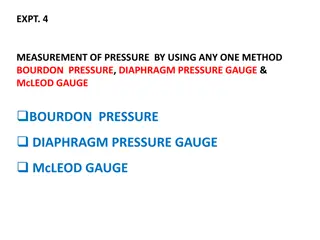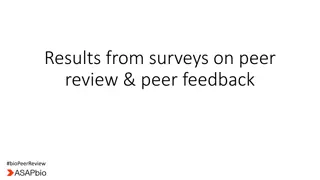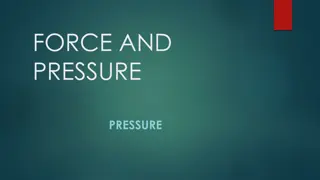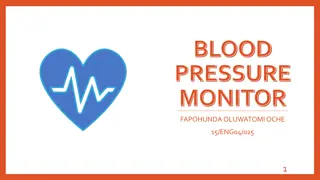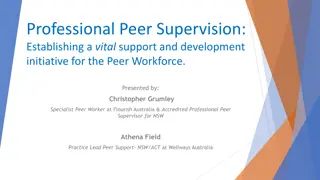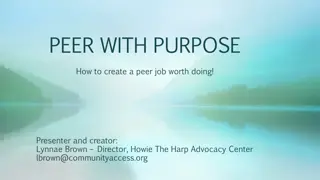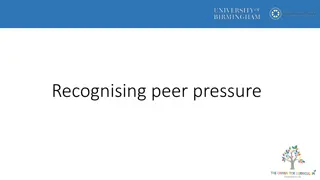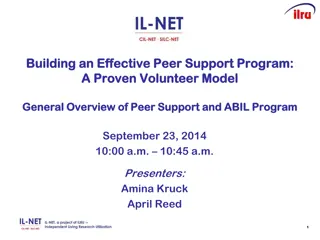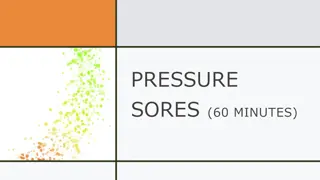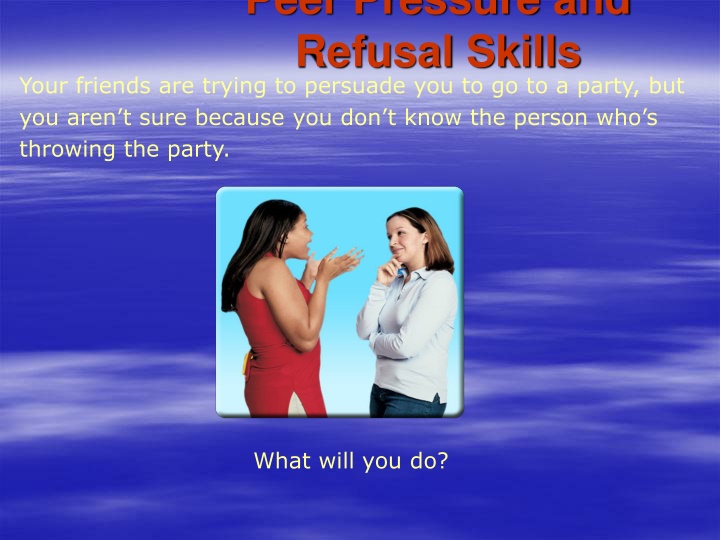
Positive and Negative Peer Pressure - Understanding and Resisting Influence
Discover the impact of peer pressure on decision-making and behaviors. Learn effective refusal strategies and ways to resist negative peer pressure. Understand the importance of surrounding yourself with supportive friends who share your values.
Download Presentation

Please find below an Image/Link to download the presentation.
The content on the website is provided AS IS for your information and personal use only. It may not be sold, licensed, or shared on other websites without obtaining consent from the author. If you encounter any issues during the download, it is possible that the publisher has removed the file from their server.
You are allowed to download the files provided on this website for personal or commercial use, subject to the condition that they are used lawfully. All files are the property of their respective owners.
The content on the website is provided AS IS for your information and personal use only. It may not be sold, licensed, or shared on other websites without obtaining consent from the author.
E N D
Presentation Transcript
Peer Pressure and Refusal Skills Your friends are trying to persuade you to go to a party, but you aren t sure because you don t know the person who s throwing the party. What will you do?
Lesson Objectives In this lesson, you ll learn to: Demonstrate refusal strategies and apply skills for making responsible decisions under pressure. Classify forms of communication such as passive, aggressive, or assertive. Analyze the relationship between the use of refusal skills and the avoidance of unsafe situations.
Peer Pressure Peer Pressure Your peers can sometimes influence how you think, feel, and act. Peer pressure can have a positive or negative influence on your actions and behaviors. It is useful to learn to evaluate forms of peer pressure and develop healthful strategies for responding to it.
Peer Pressure Positive Peer Pressure Peers can influence you in many positive ways. Positive peer pressure may involve not participating in risky behaviors or activities. You can also use positive peer pressure to influence others in healthful ways. You can be a role model by inspiring peers to take part in a positive act or a worthwhile cause.
Peer Pressure Negative Peer Pressure Peers sometimes pressure others to take part in behaviors or accept beliefs that have negative consequences. Negative peer pressure can involve harassment, which includes name-calling, teasing, or bullying. Negative peer pressure may also lead some teens to engage in behaviors that go against their values. Manipulation is another way of exerting negative peer pressure on others.
Peer Pressure Common Methods of Manipulation
Resisting Negative Peer Pressure How to Resist Peer Pressure One way to resist negative peer pressure is to avoid it. Develop friendships with people who share your values and interests. Have friends who stand by you and support your decision.
Resisting Negative Peer Pressure Things to Remember When Faced with Peer Pressure Make decisions that have the best possible effect on your well-being. It is important to remain firm and stay true to yourself. Respect yourself, stand by your values, and be assertive in your refusal. Your health and safety come first.
Resisting Negative Peer Pressure Assertive Refusal Assertive communication is when you state your position and stand your ground while acknowledging the rights of others. This is the most effective approach when facing negative peer influences.
Resisting Negative Peer Pressure Refusal Skills Effective refusal skills involve a three-step process. 1. State your position. Give an honest reason for your response. Offering a legitimate reason will help strengthen your refusal. 2. Suggest alternatives. Your suggestion is most effective if it takes you away from the dangerous or unpleasant situation. 3. Stand your ground. Use strong body language and maintain eye contact.
Resisting Negative Peer Pressure Body Language and Assertive Refusal
Resisting Negative Peer Pressure Passive and Aggressive Responses To some people, a passive response to negative peer pressure seems more natural. Passive Responses Teens who respond passively to peer pressure may believe they are making friends by going along. Aggressive Responses Passive people may be viewed as pushovers who aren t worthy of respect.
Resisting Negative Peer Pressure Assertive Communication Learning and practicing assertive communication is the most effective way to deal with peer pressure. Being assertive will help you resist negative peer pressure today, and it will also serve as a useful skill throughout your life.




